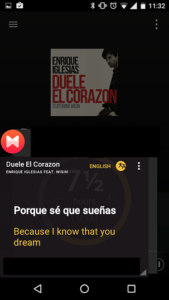
flickr photo by Thomas Hawk shared under a Creative Commons (BY-NC) license.
In this post we’ll look at technology that can help you or your students to learn a new language.
We’ve covered the popular language app, Duolingo, previously in Gamifying language learning.
But what other digital tools and social networks are available to help you learn?
Meetups
Use the web to find and meet others to practice your speaking and listening skills. Meetups are ‘neighbours getting together to learn something, do something, share something’.
There are many groups that you/students can join, most are free to attend or have a nominal fee (50p – £1). For example, Brighton Intercambio is one group that meets every Thursday to practice Spanish and English.
There is also an International Friends Language Exchange and Social which offers international students an opportunity to improve their English as well as speaking time for those interested in practising a new language. You will also find French, Polish, Japanese, German and Italian Meetups locally. You can also start your own Meetup easily.
Google Voice Typing Tool

Click the arrow to change your default language.
You can adapt your use of the Google Voice Typing to help you practice your speaking skills.
We’ve covered how to use the Google Voice Typing Tool for dictation fully in ‘Speak your documents with Google Voice Typing Tool’.
To use the tool for practising another language, activate the tool by opening your Google doc, select Tools from the menu options and then select Voice typing. Now you just need to:
- Change the language from the drop down box from your default to the language you want to practice
- Click the mic to activate
- Start speaking!
See the instant dictation of your speaking and check to see if you are pronouncing your words well enough for Google to translate.
I’ve made a short screencast to demonstrate Google Voice using Screencastify. In the example you will see that I’ve changed the default language from English to Spanish (but there are over 50 languages available, from Afrikaans to Zulu).
Read the news
Use Google Translate to help you read the news in another language. Reading current affairs can be a good way to learn. The accompanying images can help you understand the article and if you get stuck, you can translate the article back again via Google Translate webpage.

You can also add the Google Translate Chrome extension to your browser. There are alternatives for Internet Explorer and FireFox users: Google Toolbar for IE and Google Translate for FireFox.

Free learning on YouTube
YouTube offers a huge collection of video lessons covering a range of languages. See the Language Surfer’s guide to learning channels, from French to Farsi. The videos are free and all you need is a wi-fi connection.
If you don’t have a home wi-fi connection you can download video on campus using the university Eduroam or use the new ‘BrightonHovewifi’ available at Brighton Libraries and public buildings and listen to later at home!
Translate your music

The floating app provides lyrics and translations.
Have you heard of Musix Match? This is a free app and online tool advertised as ‘the world’s largest lyrics catalogue’.
Musix Match provides translated lyrics to songs.
You can use Musix Match on the web and via the app, which is available on both iOS and Android, to view translations and add to translations as you listen to music.
This could make an interesting language activity for students to curate and translate lyrics for Musix Match users.
Musix Match can be used with YouTube and Spotify. (N.B. If you are using Spotify you can get a 50% discount if you are a student/staff member with an NUS card).
Flash Sticks
 Flash Sticks are a language tool based on Post-it notes.
Flash Sticks are a language tool based on Post-it notes.
Stick your language Post-it note to any item to help you learn the word, gender and pronunciation.
The Post-it note is supported by an app (available on iOS and Android) and acts as a visual reminder for a word and demonstrates how to pro-NOUNCE it.
Label items with the Post-it notes and scan to hear and see the word pronounced. Flash Sticks also contain language games in the style of Duolingo. Flash Sticks is also available for British Sign Language.
Label items with the Post-it notes and scan to hear and see the word pronounced. Flash Sticks also contain language games in the style of Duolingo. Flash Sticks are also available for British Sign Language.
Podcasts
Seek out the digital radio of another country to help you with your language skills.
You might at first only recognise a few words but by trying to increase the different formats to which you are exposed to a new language will help you to learn.
You could use Overcast for iPhone and Podcast & Radio Addict for Android, although there are many podcasting apps available.
Periscope
Use the live streaming app, Periscope, to find a live Periscope in a country that speaks the language that you are learning. Select a Periscope broadcast via country by selecting the world icon from the top menu.
Periscope is an excellent way to see a language spoken informally and the simple commenting function makes it ideal if your vocabulary is limited. Simple hold your finger to ‘heart’ the broadcast to join in without even having any vocabulary!
You will need to be selective in what you choose to look at as broadcasts vary in quality.
Snapchat for language learning
Thanks to languages teacher, Tracy Brady, for the idea to use Snapchat as a learning tool.
Read about how you can use the disappearing message function for teaching here in ‘Snapsmashing – SnapChat (not just for kids anymore) by Tracy who you can follow on Twitter @mmebrady and read her blog.
Here are additional apps to explore if you enjoy using apps for language: Memrise, Busuu, Ihandy translator free, Babbel, Mindsnacks, Brain scape, Anki app and Mondly.
Do you have any ideas for language learning using technology?
Please let us know your teaching ideas at tel@sussex.ac.uk and we can add these to our list.






[…] Read the full story by University of Sussex Technology Enhanced Learning Blog […]